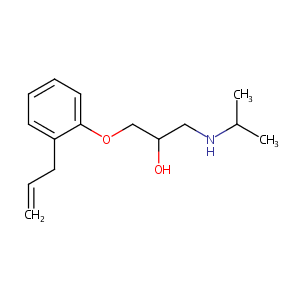Details of the Drug
General Information of Drug (ID: DMYJ8Z3)
| Drug Name |
Alprenolol
|
|||||||||||||||||||||||||
|---|---|---|---|---|---|---|---|---|---|---|---|---|---|---|---|---|---|---|---|---|---|---|---|---|---|---|
| Synonyms |
Alfeprol; Alpheprol; Alprenololum; Yobir; Alfeprol [Russian]; Alprenolol (INN); Alprenolol [INN:BAN]; Alprenololum [INN-Latin]; Apllobal (TN); Aptine (TN); Aptol (TN); Duriles (TN); Gubernal (TN); Regletin (TN); Yobir (TN); H-56-28; 1-(2-Allylphenoxy)-3-isopropylamino-2-propanol; 1-(o-Allylphenoxy)-3-(isopropylamino)-2-propanol; 1-(o-Allylphenoxy)-3-isopropylamino)-2-propanol; 1-(propan-2-ylamino)-3-(2-prop-2-enylphenoxy)propan-2-ol; 1-[2-(propen-2-ylphenoxy)]-3-(isopropylamino)propan-2-ol
|
|||||||||||||||||||||||||
| Indication |
|
|||||||||||||||||||||||||
| Therapeutic Class |
Antiarrhythmic Agents
|
|||||||||||||||||||||||||
| Drug Type |
Small molecular drug
|
|||||||||||||||||||||||||
| Structure |
 |
|||||||||||||||||||||||||
| 3D MOL | 2D MOL | |||||||||||||||||||||||||
| #Ro5 Violations (Lipinski): 0 | Molecular Weight (mw) | 249.35 | ||||||||||||||||||||||||
| Logarithm of the Partition Coefficient (xlogp) | 3.1 | |||||||||||||||||||||||||
| Rotatable Bond Count (rotbonds) | 8 | |||||||||||||||||||||||||
| Hydrogen Bond Donor Count (hbonddonor) | 2 | |||||||||||||||||||||||||
| Hydrogen Bond Acceptor Count (hbondacc) | 3 | |||||||||||||||||||||||||
| ADMET Property |
|
|||||||||||||||||||||||||
| Adverse Drug Reaction (ADR) |
|
|||||||||||||||||||||||||
| Chemical Identifiers |
|
|||||||||||||||||||||||||
| Cross-matching ID | ||||||||||||||||||||||||||
Molecular Interaction Atlas of This Drug
 Drug Therapeutic Target (DTT) |
|
||||||||||||||||||||||||||||||||||||
|---|---|---|---|---|---|---|---|---|---|---|---|---|---|---|---|---|---|---|---|---|---|---|---|---|---|---|---|---|---|---|---|---|---|---|---|---|---|
 Drug Transporter (DTP) |
|
||||||||||||||||||||||||||||||||||||
 Drug-Metabolizing Enzyme (DME) |
|
||||||||||||||||||||||||||||||||||||
 Drug Off-Target (DOT) |
|
||||||||||||||||||||||||||||||||||||
| Molecular Interaction Atlas (MIA) | |||||||||||||||||||||||||||||||||||||
References
